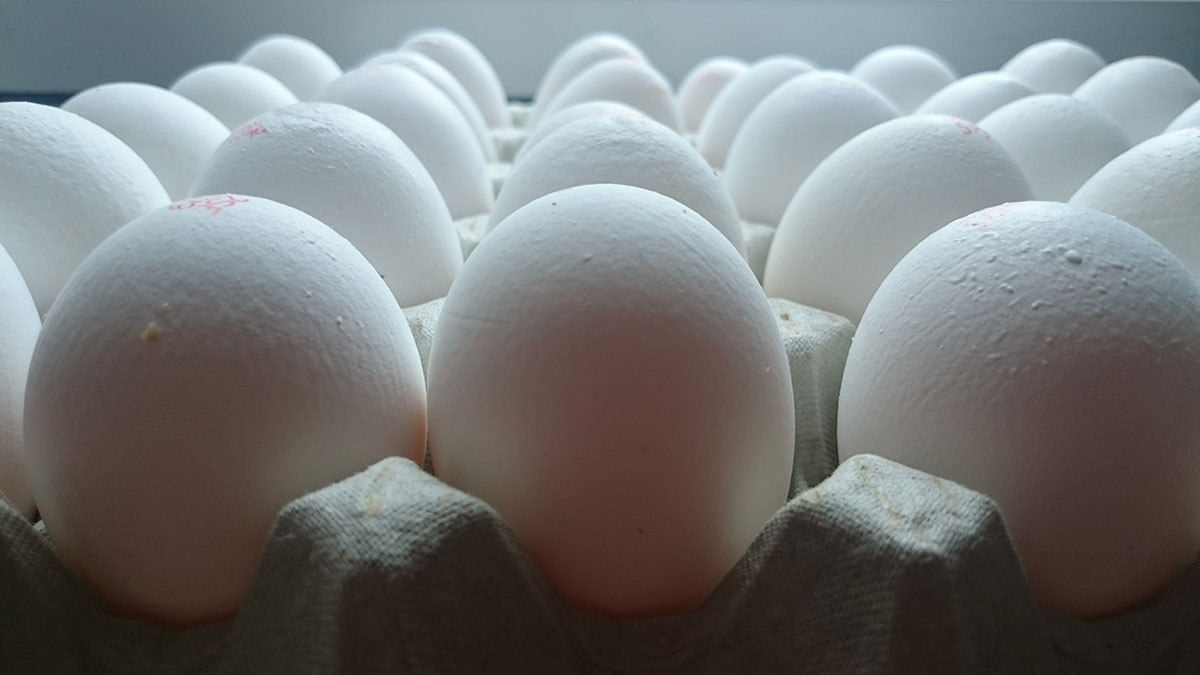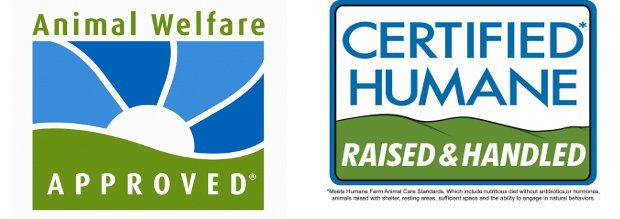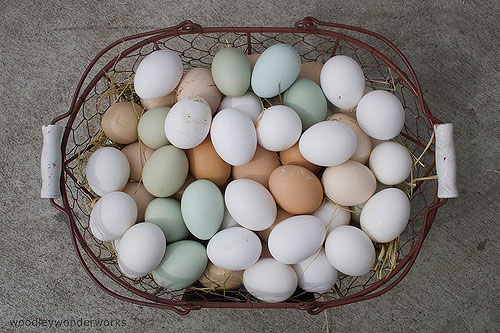The Modern Farmer Guide to Grocery Store Eggs
Not sure which eggs to buy? Here’s our guide on what’s baloney and what’s legit.
The Modern Farmer Guide to Grocery Store Eggs
Not sure which eggs to buy? Here’s our guide on what’s baloney and what’s legit.

The “Don’t Be Impressed By This” Category
No matter what nature scene a marketer puts on the package, All Natural will continue to be “just a marketing ploy,” says Mick Bessire, an agricultural educator at Cornell Cooperative Extension. “It doesn’t really have any regulatory status. It has the connotation that no antibiotics were used in the production, but that is not always the case,” he says. “They can be in battery cages or have their beaks trimmed and still be called natural.” Battery cages are small cages on conventional egg farms where chickens live out their lives. United Egg Producers (UEP), an industry trade organization and basically the industry standard (representing ownership of about 94 percent of egg-laying hens), allows 0.46 to 0.59 square feet per bird, often compared to the size of a sheet of paper. A study in British Poultry Science, however, contends that chickens need more space than that (0.58 to 1 square feet) to simply turn around.
Farm Fresh has a cute ring to it, but this, too, holds no real meaning. For best freshness indicator, find the Julian (packaging) date.
Lastly, don’t let No Hormones hold any weight in your egg choice. Is it incorrect? No. But the USDA bans hormone use in egg-laying hens, so companies that use it as a marketing ploy are essentially patting themselves on the backs for not breaking the law. Don’t give them extra credit for doing so.
The “Well-Intended but Hard to Guarantee What You’re Getting” Category
Cage-Free, Free-Range, and Pasture-Raised: Each conjures up the image of chickens pecking freely and happily around a field, but since the phrases are different, they must be held to different standards, right? The regulations spell out only qualifiable, and not quantifiable, requirements.
Cage-Free is a voluntary label recognized by the USDA’s Agricultural Marketing Service (AMS) as birds permitted to roam a room, building, or enclosure without the confines of battery cages. They aren’t guaranteed access to the outdoors, or even much personal space – again, it’s not quantified – but they do have a little more room to flap. For example, a cage-free establishment near Hershey, Pennsylvania, has 18,000 birds in house, all with no access to the outdoors but plenty of opportunity to perch and dust bathe, things chickens instinctively do for safety and hygiene respectively.
Free-Range (or Free-Roaming) is another voluntary label, which means that chickens have access to the outdoors. Specifics – like how much time and space allotted outdoors – aren’t stipulated by the AMS. Having a door on the barn doesn’t mean it actually opens for a chicken to get outside, but it does mean it’s possible. The video provides one example of what a free-range chicken farm can look like.
For eggs with cage-free and free-range claims, AMS personnel visit each egg production site twice per year to verify animal husbandry practices.
Pasture-Raised isn’t defined by the AMS. Labeling rules for pasture-raised products haven’t been developed, the organization says, “due to the number of variables involved in pasture-raised agricultural systems.”
Mike Badger, executive director of the American Pastured Poultry Producers Association, says pasture-raised (or pastured poultry) is a model in which birds are raised outdoors based on time of year, location, and age of the birds; and likely on a rotated pasture: One spot this week, a different spot next. “If you let the chickens repeatedly forage in the same ground, they’re eventually going to turn it into a dirt lot, no matter the size,” Badger says. “Rotate the pasture for both soil health and bird health. New pasture moves chickens away from their own manure onto fresh green grass, with the chance to forage for bugs.”
The “Worth Paying Attention To” Category
Says AMS spokesperson Samuel Jones-Ellard: “Even without AMS verifying the claim ‘pasture-raised,’ from a regulatory standpoint, the U.S. Food and Drug Administration (FDA) would have to make sure the claims on the packaging are correct.” Lauren Kotwicki, a spokesperson for the FDA, confirmed Jones-Ellard’s statement. And it’s worth noting that all label claims on egg cartons, regulated or not, are subject to investigation by the FDA.
Despite the lack of regulation (in terms of required space per bird, time spent inside versus outside, etc.) the three aforementioned labels have something going for them, says Badger: “their lowest common denominator – lack of cage for cage-free, ability to roam around for free-range, and time outside for pasture-raised.” However, The Cornucopia Institute released a detailed report this past winter called “Scrambled Eggs: Separating Factory Farm Production from Authentic Organic Agriculture,” highlighting the lack of consistency among organic egg brands that use these phrases. Hint: There’s a lot of it.
The USDA’s National Organic Program (NOP) has stringent rules for what’s certified and labeled Organic. By nature, Certified Organic egg-laying hens are cage-free, have access to the outdoors, and are vegetarian/organically fed. The NOP mandates “year-round access to the outdoors” – again, access doesn’t mean it’s always happening – provided it’s safe and weather-appropriate for hens to be outside. It does specify that “continuous total confinement of any animal indoors is prohibited.” Farms that follow these rules but don’t obtain certification (it takes time and money) are barred from using the USDA Organic seal on their food.
And that Cornucopia Institute report we mentioned? That only focused on USDA Certified Organic brands. Sad to say, but there are a lot of inconsistencies even with the NOP watching out. The organic egg scorecard, where Cornucopia judges egg producers on 28 different criteria including indoor and outdoor space per bird, hen lifespan, and exits to the outdoors, shows how some brands go above and beyond for their laying hens while others – particularly industrial organic operations, which can have 100,000 or more laying hens per building – do not, or at the very least, refused to be transparent enough for Cornucopia to think they do.
Though government regulation and private certification aren’t the same thing, several non-governmental organizations have their own stamp of approval visible on associated products. Egg producers voluntarily apply for consideration, and each have their own rules:
United Egg Producers Certified supports caging hens, but does present requirements for hens deemed cage-free. Each hen in a cage-free environment needs a minimum range of 1 to 1.5 square feet of floor space to itself, and nesting and perching spaces are required. No outdoor access is required.
Food Alliance Certified requires at least 1.23 square feet to 1.75 feet of space per bird and eight to 16 hours of fresh air and natural sunlight access a day. Outdoor spaces must have living vegetation designed to prevent soil erosion and water contamination. Nesting, perching, and dust-bathing opportunities are required, and severe beak trimming, toe clipping, and dubbing (cutting the wattle) are not permitted. Feed-additive antibiotics or non-therapeutics antibiotics aren’t allowed either.
American Humane Certified lays out specific requirements for enriched colony housing, cage-free, free-range, and pasture-raised. Enriched colonies cage birds, but with more space than battery cages: 0.8 square feet, each with a space for nesting and perching. Cage-free birds require 1.25 square feet of floor space as well as a place to perch and nest. Free-range requires 21.8 square feet of roaming space per bird, and pasture-raised requires 108.9 square feet of specifically outdoor space with living vegetation per bird.
Certified Humane offers three levels of certification including cage-free, free-range, and pasture-raised. Cage-free birds can be kept indoors but require nesting and perching opportunities. Free-range requires outdoor access six hours a day and 2 square feet of outdoor space. Pasture-raised requires 2.5 acres of pasture per 1,000 hens per day. While pasture-raised requires living vegetation in outdoor spaces, free-range specifies ground covered by living vegetation “where possible.”
Animal Welfare Approved recommends flocks of less than 500 birds, though each farmer may have multiple flocks. Each hen is required 1.8 square feet of indoor floor space, with opportunities to nest, perch, and dust bathe. They must also have 4 square feet of healthy outdoor space per bird where they can range and forage. AWA also stands alone as the only organization to completely ban beak trimming, the practice of trimming part of a hen’s beak meant to prevent them from pecking at each other, which, according to the AWA, has been scientifically shown to cause acute and chronic pain.

What About Grading?
In descending order, the USDA grades eggs as AA, A, or B. AAs are of the best quality, Bs are the least. Anything below a B is not graded and not put out on store shelves. To be graded at all, eggs must be clean and unbroken – B eggs are perfectly edible, and the lower rating should not necessarily discount them from your breakfast menu. Undesirable external qualities such as bumps, ridges, thin spots, or deviation from a perfect oval shape may knock an egg from a higher to a lower grade; and such internal qualities include a thinner egg white (determined by candling, where an egg is rotated over a light that allows one to see the inside contents of the shell without cracking it open), smaller yolk, and a larger air sac.
“With less of an air sac, there’s more egg to AAs,” explains Bessire. “The air sac is good if you’re hatching eggs – it gives the embryos a little more breathing room, so to speak – but it’s not particularly good if you’re looking for a bigger, better omelette.”
And Size?
The descriptors jumbo, extra large, medium, and so on refer to the average weight of one dozen eggs. This is the breakdown, which probably only matters if you’re seeking the best-size egg for a recipe:
Source: The Kitchn
What’s the Deal With Shell Color?
Your grocer’s egg fridge is likely stocked with cartons of ovoid white eggs. In the last handful of years, brown eggs have started keeping them company. Were the white ones bleached? Are the brown ones healthier? Rumors abound, but both answers are no.
Egg color depends on the breed of hen and can range from white, cream, brown, blue, and green. According to Bessire, hens tend to lay eggs with a color related to that of their earlobes, not their feathers. Red earlobes? Brown eggs. White earlobes? White eggs.

What Does the Color Inside Mean?
Deeper yolk color indicates a diet higher in carotenoids, which are natural red, orange, or yellow pigments found in plants. Carotenoids are essential antioxidants, and a diet higher in carotenoids is common with chickens who are allowed to forage for plants and bugs. Similar to a fan of paint colors from the hardware store, the DSM YolkFan contains possible yolk shades ranging from light yellow and deep orange. It’s the industry’s standard tool for measuring egg yolk color.
However, manipulating egg yolk color is easy enough. Chickens that have eaten red chiles have darker yolks due to the active dye naturally within the chiles; and paprika and marigold petals are also used to “micromanage” egg yolk color.
If you know where your eggs come from, perhaps you can ask your farmer if he or she uses natural dye sources to pigment yolk color.
Bottom Line
Boil ’em, fry ’em, poach ’em, scramble ’em. There’s no denying the versatility of the incredible, edible egg. From breakfast staple and baking ingredient, they end up in our fridges for a number of reasons… but first, we’re presented with the option to buy this carton or that carton, painted with different phrases we’re left to guess about and perhaps a grazing chicken graphic.
So what to choose? The Cornucopia Institute’s “Scrambled Eggs” report includes a report card on various brands’ treatment of chickens and land: Start there by looking up the brands in your grocer’s fridge. Seek brands with multiple stamps of approval from organizations with high standards. Or, find a farm near you and visit it: See your farmers’ faces, their fields, their chickens, their eggs. Gauge quality of life for the chickens, and know that any money spent on your local farm will increase the quality of your farmers’ lives, too.
Follow us
This work is licensed under a Creative Commons Attribution-NoDerivatives 4.0 International License.
Want to republish a Modern Farmer story?
We are happy for Modern Farmer stories to be shared, and encourage you to republish our articles for your audience. When doing so, we ask that you follow these guidelines:
Please credit us and our writers
For the author byline, please use “Author Name, Modern Farmer.” At the top of our stories, if on the web, please include this text and link: “This story was originally published by Modern Farmer.”
Please make sure to include a link back to either our home page or the article URL.
At the bottom of the story, please include the following text:
“Modern Farmer is a nonprofit initiative dedicated to raising awareness and catalyzing action at the intersection of food, agriculture, and society. Read more at <link>Modern Farmer</link>.”
Use our widget
We’d like to be able to track our stories, so we ask that if you republish our content, you do so using our widget (located on the left hand side of the article). The HTML code has a built-in tracker that tells us the data and domain where the story was published, as well as view counts.
Check the image requirements
It’s your responsibility to confirm you're licensed to republish images in our articles. Some images, such as those from commercial providers, don't allow their images to be republished without permission or payment. Copyright terms are generally listed in the image caption and attribution. You are welcome to omit our images or substitute with your own. Charts and interactive graphics follow the same rules.
Don’t change too much. Or, ask us first.
Articles must be republished in their entirety. It’s okay to change references to time (“today” to “yesterday”) or location (“Iowa City, IA” to “here”). But please keep everything else the same.
If you feel strongly that a more material edit needs to be made, get in touch with us at [email protected]. We’re happy to discuss it with the original author, but we must have prior approval for changes before publication.
Special cases
Extracts. You may run the first few lines or paragraphs of the article and then say: “Read the full article at Modern Farmer” with a link back to the original article.
Quotes. You may quote authors provided you include a link back to the article URL.
Translations. These require writer approval. To inquire about translation of a Modern Farmer article, contact us at [email protected]
Signed consent / copyright release forms. These are not required, provided you are following these guidelines.
Print. Articles can be republished in print under these same rules, with the exception that you do not need to include the links.
Tag us
When sharing the story on social media, please tag us using the following: - Twitter (@ModFarm) - Facebook (@ModernFarmerMedia) - Instagram (@modfarm)
Use our content respectfully
Modern Farmer is a nonprofit and as such we share our content for free and in good faith in order to reach new audiences. Respectfully,
No selling ads against our stories. It’s okay to put our stories on pages with ads.
Don’t republish our material wholesale, or automatically; you need to select stories to be republished individually.
You have no rights to sell, license, syndicate, or otherwise represent yourself as the authorized owner of our material to any third parties. This means that you cannot actively publish or submit our work for syndication to third party platforms or apps like Apple News or Google News. We understand that publishers cannot fully control when certain third parties automatically summarize or crawl content from publishers’ own sites.
Keep in touch
We want to hear from you if you love Modern Farmer content, have a collaboration idea, or anything else to share. As a nonprofit outlet, we work in service of our community and are always open to comments, feedback, and ideas. Contact us at [email protected].by Gabrielle Saulsbery, Modern Farmer
March 18, 2016
Modern Farmer Weekly
Solutions Hub
Innovations, ideas and inspiration. Actionable solutions for a resilient food system.
ExploreExplore other topics
Share With Us
We want to hear from Modern Farmer readers who have thoughtful commentary, actionable solutions, or helpful ideas to share.
SubmitNecessary cookies are absolutely essential for the website to function properly. This category only includes cookies that ensures basic functionalities and security features of the website. These cookies do not store any personal information.
Any cookies that may not be particularly necessary for the website to function and are used specifically to collect user personal data via analytics, ads, other embedded contents are termed as non-necessary cookies.
Years ago in the 70s, I bought a dozen eggs from a lady that raised chickens in her back yard. They had the most flavorful yolks I’d ever tasted; almost orange. I yearn for that again.